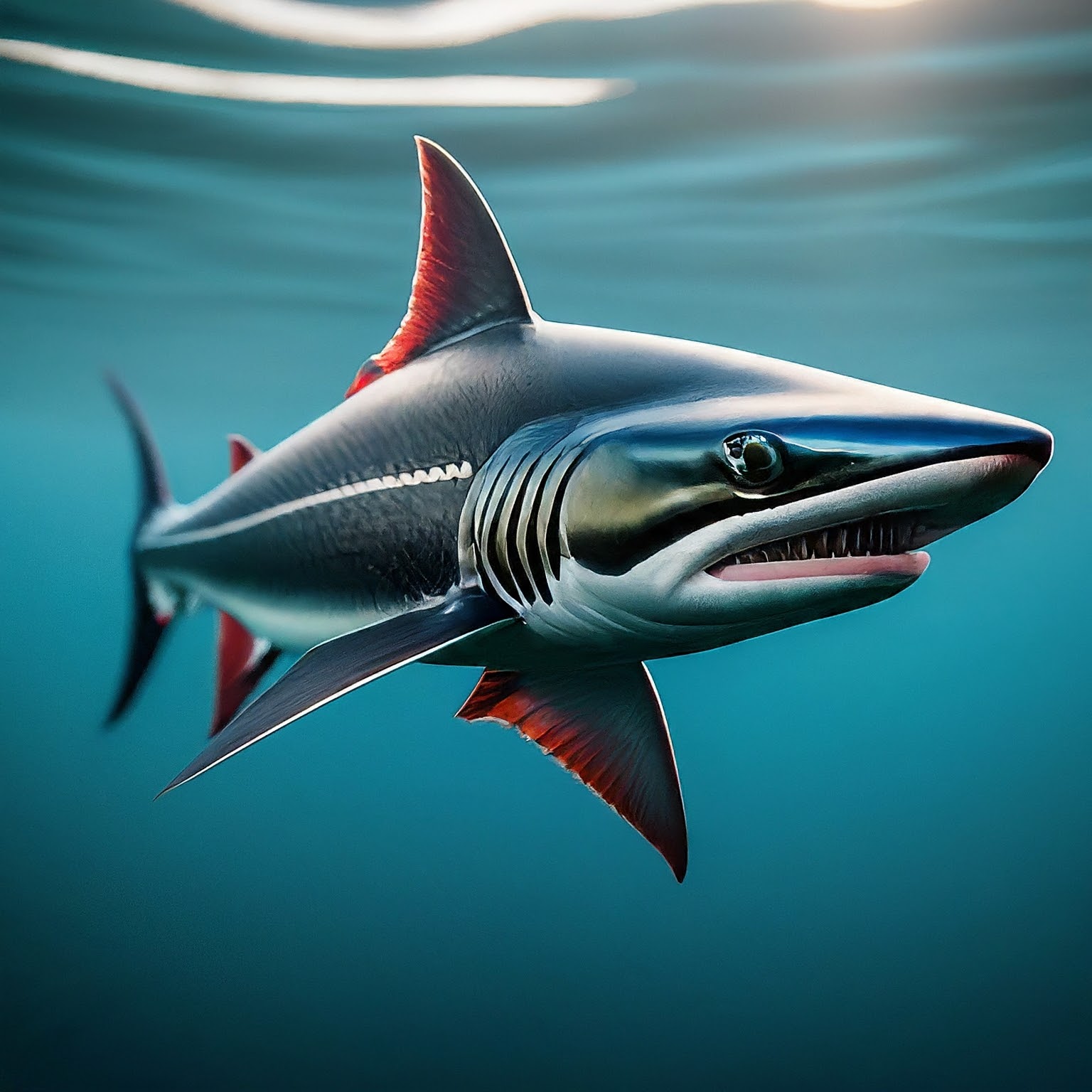The Salmon Shark (Lamna ditropis) emerges as a captivating predator inhabiting the oceanic realms. In this comprehensive article, we will explore various facets of the Salmon Shark, from its scientific classification to its ecological role, emphasizing its significance in marine ecosystems.
Table of Contents
ToggleSalmon Shark Scientific Classification
Before delving into the depths of its existence, let’s establish the scientific classification of the Salmon Shark:
- Kingdom: Animalia
- Phylum: Chordata
- Class: Chondrichthyes
- Order: Lamniformes
- Family: Lamnidae
- Genus: Lamna
- Species: ditropis
Salmon Shark Identification, Appearance, and Anatomy
Identification
The Salmon Shark possesses distinctive features that aid in its recognition:
- Body Shape: Streamlined and torpedo-like, facilitating swift movements.
- Coloration: Dark blue to black on the dorsal side, transitioning to a lighter shade on the ventral side.
- Dorsal Fin: Prominent and triangular, often with a dark patch near the base.
Anatomy
Understanding the internal and external anatomy sheds light on the adaptations that make the Salmon Shark an apex predator:
- Teeth: Sharp, serrated teeth designed for grasping and tearing prey.
- Eyes: Large and well-adapted for low light conditions.
- Pectoral Fins: Long and pointed, contributing to agility.
Salmon Shark Physical Characteristics
Exploring the physical attributes of the Salmon Shark enhances our comprehension of its ecological role:
- Size: Adult Salmon Sharks typically reach lengths of 6 to 8 feet, with some individuals exceeding this range.
- Weight: Adult weights range from 200 to 500 pounds on average.
- Temperature Regulation: Like other members of the Lamnidae family, the Salmon Shark is endothermic, capable of maintaining a higher internal body temperature than the surrounding water.
Salmon Shark Types and Varieties
The Salmon Shark does not exhibit distinct subspecies or recognized varieties within its classification.
Salmon Shark Weight, Height, Size, and Teeth
Understanding the dimensions and dental features of the Salmon Shark provides insights into its ecological role:
- Weight Variation: Adult Salmon Sharks generally weigh between 200 to 500 pounds, with variations based on age, sex, and individual factors.
- Length: Ranging from 6 to 8 feet, although larger specimens have been recorded.
- Teeth Structure: Adapted for a carnivorous diet, Salmon Shark teeth are sharp, allowing for efficient predation.
Salmon Shark Distribution, Migrations, and Habitat
Unraveling the geographical range, migratory patterns, and preferred habitats of Salmon Sharks is crucial to understanding their ecological significance:
- Global Distribution: Salmon Sharks are primarily found in the North Pacific Ocean, with notable concentrations in the Gulf of Alaska and the Bering Sea.
- Migratory Behavior: They exhibit extensive migratory patterns, often following the seasonal movements of their prey.
- Habitat Preference: Salmon Sharks are associated with colder waters and are commonly found in both coastal and offshore environments.
Salmon Shark Food and Diet
The dietary preferences of Salmon Sharks highlight their role as top predators in marine ecosystems:
- Feeding Behavior: Salmon Sharks are opportunistic predators, preying on a variety of fish, including salmon, herring, and squid.
- Seasonal Diets: Their diet often aligns with the migratory patterns of Pacific salmon, earning them their name.
Salmon Shark Reproduction and Lifespan
The reproductive biology and lifespan of Salmon Sharks provide insights into their life histories:
- Ovoviviparous Reproduction: Female Salmon Sharks give birth to live pups after the eggs hatch within their bodies.
- Litter Size: Generally, a small number of pups are born in each reproductive cycle.
- Lifespan: The average lifespan of Salmon Sharks is estimated to be around 20 to 30 years.
Salmon Shark Conservation, Efforts, and Threats
Amidst growing concerns about the health of marine ecosystems, understanding the conservation status, ongoing efforts, and potential threats to Salmon Sharks is of paramount importance:
- Conservation Status: The Salmon Shark does not currently have a specific conservation status on the International Union for Conservation of Nature (IUCN) Red List.
- Bycatch Concerns: Salmon Sharks may face threats from bycatch in commercial fisheries targeting other species, emphasizing the need for sustainable fishing practices.
Salmon Shark Predators and Preys
Despite their status as apex predators, Salmon Sharks may face threats from larger predators and human activities:
- Predators: Larger sharks, such as great whites, may pose a threat to Salmon Sharks, especially juveniles.
- Human Activities: Overfishing and bycatch in commercial fisheries represent potential threats to Salmon Shark populations.
Salmon Shark Facts
- Salmon Migration Synchronization: Salmon Sharks are known for synchronizing their migrations with the movements of Pacific salmon, making them effective predators during salmon runs.
- High Energy Demand: The endothermic nature of Salmon Sharks requires them to consume substantial amounts of food to maintain their internal body temperature.
Salmon Shark Related FAQ’s
- Why are Salmon Sharks Associated with Salmon?
- Salmon Sharks are named for their close association with Pacific salmon, as they often feed on salmon during their migrations.
- Do Salmon Sharks Pose a Threat to Humans?
- There is minimal evidence of Salmon Sharks posing a threat to humans. They are generally not considered a danger to swimmers or divers.
- How Can Humans Contribute to Salmon Shark Conservation?
- Contributing to sustainable fishing practices, supporting marine conservation initiatives, and raising awareness about the importance of preserving marine ecosystems all play a role in Salmon Shark conservation.
Conclusion
In conclusion, the Salmon Shark stands as a remarkable predator, intricately linked to the health of marine ecosystems. Understanding its scientific classification, anatomy, ecological role, and potential threats allows us to appreciate the delicate balance that sustains ocean life. As we navigate the challenges of marine conservation, responsible fisheries management, and global cooperation become imperative to ensure the continued presence of the Salmon Shark in our oceans. Through science-based approaches, sustainable practices, and collective efforts, we can contribute to the preservation of this majestic species, securing its place in the vast tapestry of marine biodiversity for generations to come.
